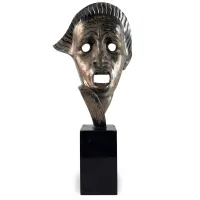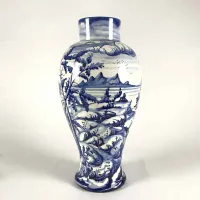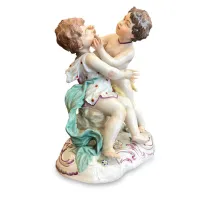Two cherubs in loving and playful attitudes in hand-painted polychrome porcelain
Exclusive antique furniture and accessories
SKU: ANT-A543
See other products from category Vintage porcelain and ceramics or from manufacturer Antyki with shipping within 24 hours
Description
Group with German Porcelain Putti Early 1900s, a group of hand-painted polychrome porcelain, in perfect condition of German origin, Passau manufacture, consisting of figures of two cherubs in loving and playful poses, sitting on a stone placed on an oval base.
Prestigious antique furniture and accessories can be an excellent idea for decorating our interiors. Today, there are more and more enthusiasts of high-quality old products that have a specific character and soul. It's a nod to the history, creation, and design of classic and timeless furniture. There are many different styles in antique furniture, each with its distinctive features.
There are many different styles characterizing antique furniture, but we can distinguish a few key ones. Eclectic furniture belongs to the 19th century, with the reigning Biedermeier style. Its variations in the early years of this century include Neo-Gothic, Gothic, Rococo, Louis Philippe style, and finally the English Victorian style. By the end of the century, these styles transition into pseudo styles of Classicism, Renaissance, and Baroque.
Empire style furniture spans the period between the late 18th and early 19th centuries. It originated during Napoleon's reign, featuring significant similarities and references to Roman and Greek decorations.
Classicist furniture is the Louis XVI style, which also strongly references ancient architecture. Interesting and noteworthy are all antique products in the Rococo and Louis XV styles. Next is Baroque, whose name comes from the Portuguese 'barocco'—meaning an irregularly developed pearl. These were very representative pieces of furniture, meant to literally drip with splendor and play a significant role in luxury. Exceptional, selectively used materials were employed to further emphasize the lofty tone of these products.
Today, we can observe how much influence the Baroque style had on today's classic furniture, which is designed with great similarity to the past era. Another significant style is the Renaissance, which flourished in the 15th and 16th centuries and also left a significant mark on the art of furniture making. Renaissance style was quite heavy and massive. Brown stains were used, as well as cornices, strong plinths, and bas-reliefs. It can certainly be said that these were quite specific products, but they provided many new possibilities, such as the construction of sideboards or generally broadly understood chest furniture. Here, too, there was an interest in mythology and ancient times, so supports or legs took on animal forms.
Lion paws, eagle heads—these are common sights in the Renaissance style. Currently, many global brands recreate such furniture, taking examples from Italian or French creators. This is a manifestation of admiration and care for the history of the most beautiful Renaissance antiques. It is important to remember that in each country, furniture making was perceived differently, so each style in a given country had its own distinct character. This is very important, especially when searching for the right elegant antique for your interior.
The most important aspect of prestigious antique furniture is originality. And this is ultimately important from the buyer's perspective, as there are many counterfeits on the market. Luxury Products provides a document confirming the product's compliance with the actual description and photo. At your disposal, we have art appraisers, historians, and experts from around the world.
Attributes / Details
| SKU | ANT-A543 |
| Manufacturer | Antyki |
| Model | A543 |
| Material | porcelain |
| Size | Height: 22 cm Width: 22 cm Depth: 11 cm |
| Wiek | XX |
| Rok | 1901 |
| Destiny | To living room |
See catalog
Reviews
No reviews for this product.












